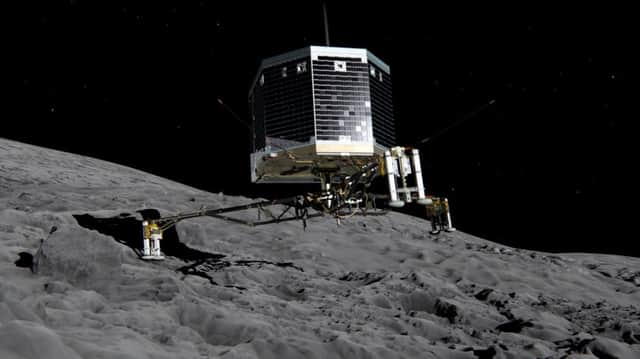Philae may be sitting on comet life say scientists


Distinct features of the comet 67P/Churyumov-Gerasimenko, such as its organic-rich black crust, are best explained by the presence of living organisms beneath an icy surface, they claim.
Rosetta, the European space craft orbiting the comet, is also said to have picked up strange “clusters” of organic material that look suspiciously like viral particles.
Advertisement
Hide AdAdvertisement
Hide AdBut neither Rosetta nor its lander are equipped to search for direct evidence of life after a proposal to include this in the mission was allegedly laughed out of court.
Astronomer and astrobiologist Professor Chandra Wickramasinghe, who was involved in the mission planning 15 years ago, said: “I wanted to include a very inexpensive life-detection experiment. At the time it was thought this was a bizarre proposition.”
He and colleague Dr Max Wallis, from the University of Cardiff, believe 67P and other comets like it could provide homes for living microbes similar to the “extremophiles” that inhabit the most inhospitable regions of the Earth.
Comets may have helped to sow the seeds of life on Earth and possibly other planets such as Mars early in the life of the solar system, they argue.
The astronomers will today present their case for life on 67P at the Royal Astronomical Society’s National Astronomy Meeting in Llandudno, Wales.
Philae made history last November after detaching from its Rosetta mothership and bouncing down on to the surface of the comet, coming to rest close to a cliff or crater wall.
After being forced into hibernation by the lack of sunlight reaching its solar panels, the probe has delighted scientists by “waking up” as the comet races towards the sun.
The comet, described as looking like a “rubber duck”, has two lobes joined by a thinner neck and measures around 2.5 miles across. Currently it is about 176.7 million miles from Earth and travelling at more than 73,000 mph.
Advertisement
Hide AdAdvertisement
Hide AdProf Wickramasinghe and Dr Wallis have carried out computer simulations that suggest microbes could inhabit watery regions of the comet. Organisms containing anti-freeze salts could be active at temperatures as low as minus 40C, their research shows.
The comet has a black hydrocarbon crust overlaying ice, smooth icy “seas”, and flat-bottomed craters containing “lakes” of re-frozen water overlain with organic debris.
Prof Wickramasinghe said: “What we’re saying is that data coming from the comet seems to unequivocally, in my opinion, point to micro-organisms being involved in the formation of the icy structures, the preponderance of aromatic hydrocarbons, and the very dark surface.
“These are not easily explained in terms of pre-biotic chemistry. The dark material is being constantly replenished as it is boiled off by heat from the sun. Something must be doing that at a fairly prolific rate.”
He said several cracks in the ice had been shown to be “spewing out material” that is falling on to the surface.